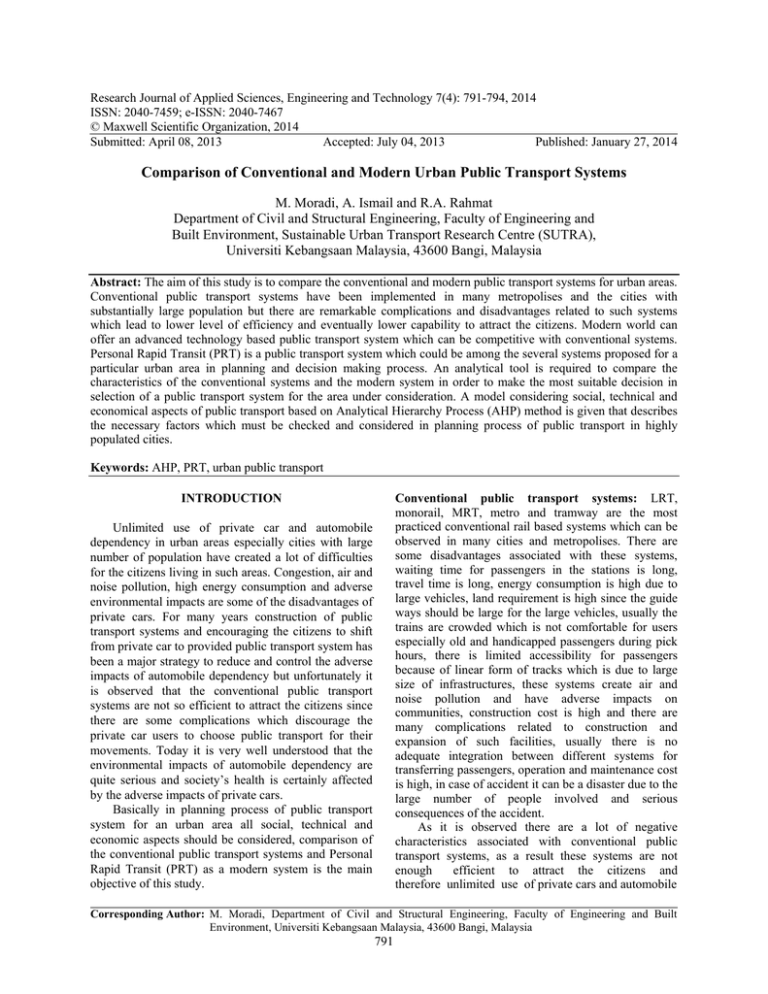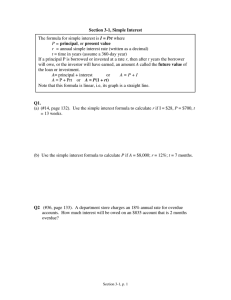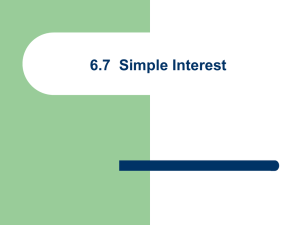Research Journal of Applied Sciences, Engineering and Technology 7(4): 791-794,... ISSN: 2040-7459; e-ISSN: 2040-7467
advertisement

Research Journal of Applied Sciences, Engineering and Technology 7(4): 791-794, 2014 ISSN: 2040-7459; e-ISSN: 2040-7467 © Maxwell Scientific Organization, 2014 Submitted: April 08, 2013 Accepted: July 04, 2013 Published: January 27, 2014 Comparison of Conventional and Modern Urban Public Transport Systems M. Moradi, A. Ismail and R.A. Rahmat Department of Civil and Structural Engineering, Faculty of Engineering and Built Environment, Sustainable Urban Transport Research Centre (SUTRA), Universiti Kebangsaan Malaysia, 43600 Bangi, Malaysia Abstract: The aim of this study is to compare the conventional and modern public transport systems for urban areas. Conventional public transport systems have been implemented in many metropolises and the cities with substantially large population but there are remarkable complications and disadvantages related to such systems which lead to lower level of efficiency and eventually lower capability to attract the citizens. Modern world can offer an advanced technology based public transport system which can be competitive with conventional systems. Personal Rapid Transit (PRT) is a public transport system which could be among the several systems proposed for a particular urban area in planning and decision making process. An analytical tool is required to compare the characteristics of the conventional systems and the modern system in order to make the most suitable decision in selection of a public transport system for the area under consideration. A model considering social, technical and economical aspects of public transport based on Analytical Hierarchy Process (AHP) method is given that describes the necessary factors which must be checked and considered in planning process of public transport in highly populated cities. Keywords: AHP, PRT, urban public transport Conventional public transport systems: LRT, monorail, MRT, metro and tramway are the most practiced conventional rail based systems which can be observed in many cities and metropolises. There are some disadvantages associated with these systems, waiting time for passengers in the stations is long, travel time is long, energy consumption is high due to large vehicles, land requirement is high since the guide ways should be large for the large vehicles, usually the trains are crowded which is not comfortable for users especially old and handicapped passengers during pick hours, there is limited accessibility for passengers because of linear form of tracks which is due to large size of infrastructures, these systems create air and noise pollution and have adverse impacts on communities, construction cost is high and there are many complications related to construction and expansion of such facilities, usually there is no adequate integration between different systems for transferring passengers, operation and maintenance cost is high, in case of accident it can be a disaster due to the large number of people involved and serious consequences of the accident. As it is observed there are a lot of negative characteristics associated with conventional public transport systems, as a result these systems are not enough efficient to attract the citizens and therefore unlimited use of private cars and automobile INTRODUCTION Unlimited use of private car and automobile dependency in urban areas especially cities with large number of population have created a lot of difficulties for the citizens living in such areas. Congestion, air and noise pollution, high energy consumption and adverse environmental impacts are some of the disadvantages of private cars. For many years construction of public transport systems and encouraging the citizens to shift from private car to provided public transport system has been a major strategy to reduce and control the adverse impacts of automobile dependency but unfortunately it is observed that the conventional public transport systems are not so efficient to attract the citizens since there are some complications which discourage the private car users to choose public transport for their movements. Today it is very well understood that the environmental impacts of automobile dependency are quite serious and society’s health is certainly affected by the adverse impacts of private cars. Basically in planning process of public transport system for an urban area all social, technical and economic aspects should be considered, comparison of the conventional public transport systems and Personal Rapid Transit (PRT) as a modern system is the main objective of this study. Corresponding Author: M. Moradi, Department of Civil and Structural Engineering, Faculty of Engineering and Built Environment, Universiti Kebangsaan Malaysia, 43600 Bangi, Malaysia 791 Res. J. Appl. Sci. Eng. Technol., 7(4): 791-794, 2014 transport systems such as LRT, monorail, MRT, metro and tramway, but considering PRT as a choice among the proposed systems in planning process of public transport for a particular area it should be determined that how efficient is the new system (PRT) compared to the conventional systems, to answer this question an analytical tool which is able to analyze and compare the proposed systems is necessary. A decision making model can assist the planners and engineers to select the most efficient and appropriate system for an existing scenario of urban area. Analytical Hierarchy Process (AHP) method could be used to create a model for decision making purpose (Saaty, 1980). The model based on AHP method will provide the ranking table of proposed public transport systems in an urban area and then the position of PRT compared to conventional systems can be determined, based on the ranking table decision about the selection of PRT or a conventional transport system for a particular situation can be made. Various factors contribute in success or failure of a transport system; several technical factors are remarkably important in public transport system for an urban area but there are some other factors which must be considered in planning process. The influencing parameters in planning of public transport system can be classified into three groups: Fig. 1: Personal Rapid Transit (PRT) station Fig. 2: Personal Rapid Transit (PRT) guide way dependency still remains as a major and serious problem in urban areas. It seems that cities and metropolises should look for other types of public transport in order to reduce the adverse impacts on communities. Personal Rapid Transit well known as PRT is a system which can be considered as an alternative in urban transportation. • • • Personal Rapid Transit (PRT) and advantages: Personal Rapid Transit (PRT) is a mode of public transport based on modern technologies which offer some advantages to the users of the system (Anderson, 1996, 2005, 2007). PRT provides a 24 h service with point to point characteristic which means no transfer at all, it is an on demand service without waiting for vehicle (Fig. 1). It provides a private trip for its passengers including family members or a group of passengers who want to travel together for example friends, it is very comfortable for old passengers and disables, it is an Automated Guide way Transit (AGT) with highest level of safety (Irving et al., 1978), every passenger would have a seat and even enough space for bicycle, baby carriage and wheelchair, the vehicles are either heated or air conditioned, the trip is very smooth and there is very little noise, it is easy to construct and expand the facilities since the guide ways are small which is due to small vehicles, it provides more accessibility for passengers due to network form of tracks and land requirement is significantly low due to small guide ways (Fig. 2). Social factors Technical factors Economical factors Obviously to obtain a comprehensive decision making model all the social, technical and economical parameters should be considered in the model. In fact there will be three AHP models including social model, technical model and economical model. MODELING AND DISSCUSSION Social factors (Table 1) are the criteria in social decision making model based on AHP method and the output of the model is the most suitable public transport system from social perspective. Technical parameters (Table 2) are considered in the technical decision making model which leads to the selection of the most technically efficient public transport system and the economical decision making model based on economic factors (Table 3) will determine the most suitable public transport system in terms of cost and benefit. The final decision to select the public transport system for a particular urban area would be made based on the results from these three models. As mentioned before the selection of the most efficient and appropriate public transport system for an urban area depends on the results from the social, technical and economical decision making models based on Analytical Hierarchy Process (AHP) method. In other words the selection of the most appropriate system is based on the overall performance of the proposed systems (Fig. 3). METHODOLOGY As explained before modern public transport systems such as Personal Rapid Transit (PRT) and other new systems could be effective solution for the complications and deficiencies of conventional public 792 Res. J. Appl. Sci. Eng. Technol., 7(4): 791-794, 2014 Fig. 3: Public transport decision making model Table 1: Social criteria and sub criteria Social criteria Travel time Safety Comfort Table 4: Overall performance of public transport system Public transport Social Technical Economical system model model model PT (1) WS (1) WT (1) WE (1) PT (2) WS (2) WT (2) WE (2) PT (3) WS (3) WT (3) WE (3) . . . . . . . . . . . . . . . . . . . . PT (n) WS (n) WT (n) WE (n) Sub criteria Privacy Accessibility Availability Table 2: Technical criteria and sub criteria Technical criteria Sub criteria Design and construction aspects Energy consumption Ease of construction Integration with other modes Expansion potential Environmental impacts Pollution Aesthetics Capacity Safety - Overall weight W (1) W (2) W (3) . . . . . W (n) economical factors considered in the models contribute to determine the overall performance of the systems and the selected public transport system would have the highest overall weight which means highest overall performance: Table 3: Economical criteria and sub criteria Economical criteria Sub criteria Cost Design and construction cost Operation and maintenance cost Benefit to community Cost of accidents - W (n) = [WS (n) + WT (n) + WE (n)] /3 where, W (n) = Overall weight of system number n WS (n) = Weight of system number n form social model WT (n) = Weight of system number n from technical model WE (n) = Weight of system number n from economical model The overall performance of systems would be determined by overall weight which depends on the weight of systems from social, technical and economical models. In fact all the social, technical and 793 Res. J. Appl. Sci. Eng. Technol., 7(4): 791-794, 2014 REFERENCES The public transport system with highest overall Weight (W) would be the most efficient and suitable system (Table 4). The ranking table of proposed systems from social, technical and economical models could be obtained and also the ranking table of the systems in terms of overall performance would be provided. Anderson, J.E., 1996. Some Lessons from the History of Personal Rapid Transit (PRT). Paper was Presented at a Conference on PRT and Other Emerging Transit Systems. Minneapolis, MN. Anderson, J.E., 2005. The future of high capacity PRT. Proceeding of Advanced Automated Transit Systems (AATS) European Conference. Bologna, Italy, pp: 7-8. Anderson, J.E., 2007. High-capacity personal rapid transit: Rationale, attributes, status, economics, benefits. PRT International, LLC Minneapolis, Minnesota, USA. Irving, J.H., H. Bernstein, C.L. Olson and J. Buyan, 1978. Fundamentals of Personal Rapid Transit. Lexington Books, Lexington, MA, ISBN: 0-66902520-8. Saaty, T.L., 1980. The Analytical Hierarchy Process, Planning, Priority, Resource Allocation. McGrawHill, New York. CONCLUSION Basically the best public transport system for a particular urban area is a system which meets all the social, technical and economical criteria and is in higher position in the ranking tables of three mentioned models. PRT as a choice would be compared to the other conventional systems and its efficiency would be determined according to the results and outputs of social, technical and economical models and it provides a clear picture for public transport planners and decision makers. 794






